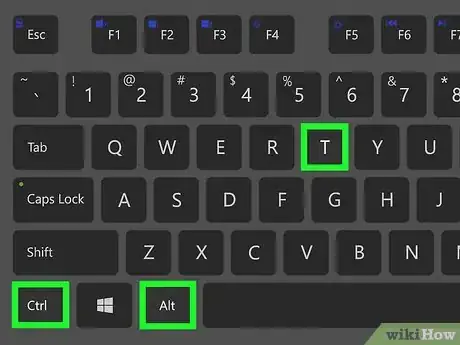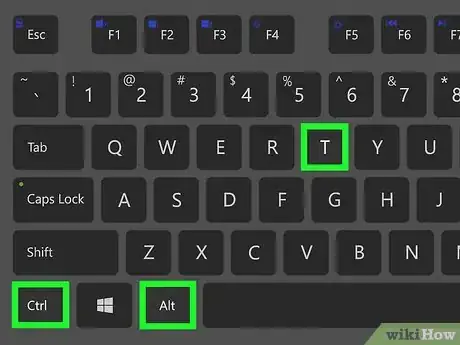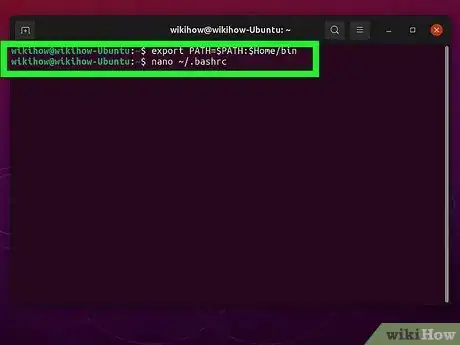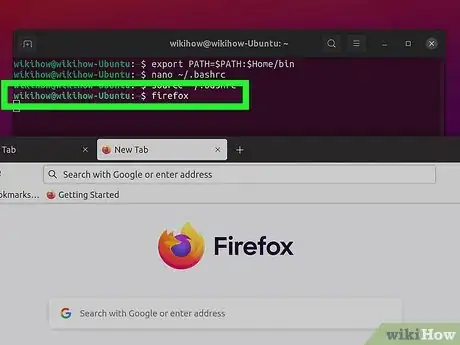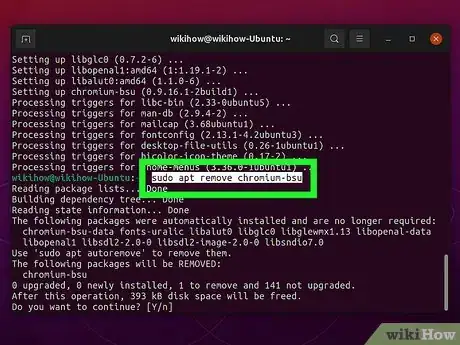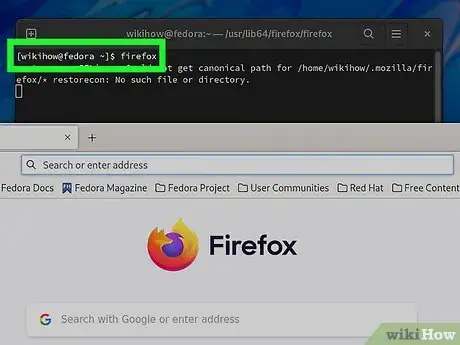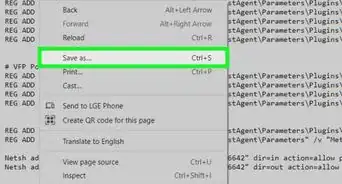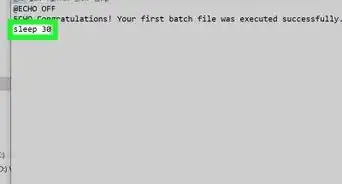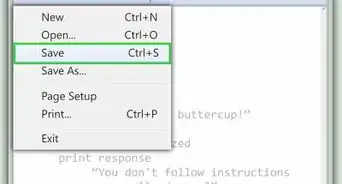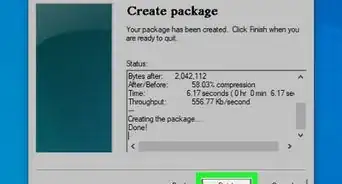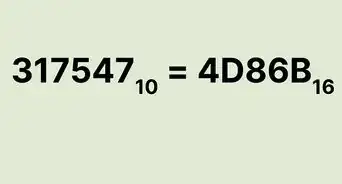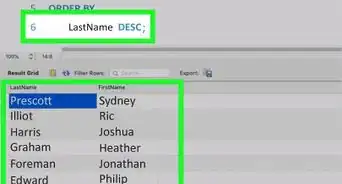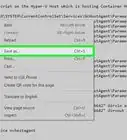This article was co-authored by wikiHow staff writer, Travis Boylls. Travis Boylls is a Technology Writer and Editor for wikiHow. Travis has experience writing technology-related articles, providing software customer service, and in graphic design. He specializes in Windows, macOS, Android, iOS, and Linux platforms. He studied graphic design at Pikes Peak Community College.
The wikiHow Tech Team also followed the article's instructions and verified that they work.
This article has been viewed 186,079 times.
Learn more...
Most Linux distributions have a graphical user interface that allows you to open programs by just clicking on the program's icon in the Apps menu. However, there are situations where you may want to run a program from the Terminal. The Terminal is a powerful tool that allows you to run programs and manage your Linux system using keyboard commands. This wikiHow teaches you how to run a program from the Terminal in Linux.
Steps
Running a Program From the Terminal
-
1Press Ctrl+Alt+T to open the Terminal. You can open the Terminal using the keyboard shortcut on most Linux distributions. The keyboard shortcut is Ctrl + Alt + T. You can also click the Terminal icon in your Apps menu. It generally has an icon that resembles a black screen with a white text cursor.
-
2Type the name of the program and press ↵ Enter. Unlike the Windows command-line (CMD), you do not need to type out the full directory path or change directories for most programs in Linux. As long as a program is in your user "$PATH" variable, Linux will search $PATH for the program and launch it automatically.
- For example, if you want to run Firefox from the Terminal, you would simply type firefox and press Enter.
- Type -h or --help after the program name to display the help menu for that program. Many programs have additional command modifiers you can use to launch the program in a specific way. For example, you can launch a website in a web browser by typing the web browser name followed by the web address and press Enter to launch that website in the web browser (i.e. firefox www.wikihow.com.
- If you receive a message that says you don't have permission to run a program or access is denied, type sudo before the program name and press Enter. The "sudo" command allows regular users to run Terminal commands with administrative privileges or root access.
- If you want to run a C or C++ program from the Terminal, you will first need to complie the program before you can launch it from the Terminal.
Running a Program Outside the $PATH Variable
-
1Press Ctrl+Alt+T to open the Terminal. You can open the Terminal using the keyboard shortcut on most Linux distributions. The keyboard shortcut is Ctrl + Alt + T. You can also click the Terminal icon in your Apps menu. It generally has an icon that resembles a black screen with a white text cursor.
-
2Type cd followed by a space and the location the program file is saved to. If the program launch file is saved to a location that is not in your $PATH variable, then you will need to navigate to that location inside the Terminal. You can do so using the "cd" command. For example, if you have folder for Python programs saved in your "Documents" folder, you can navigate to it in the Terminal by typing cd ~/Documents/Python or something similar, and then press Enter.
-
3Type chmod a+x [filename] and press ↵ Enter. Replace "filename" with the actual launch file of the program. The "chmod a+x" command tells Linux the file is an executable file.[1]
-
4Type "./" followed by the launch filename and press ↵ Enter. This launches the program. For example, if you have a Python file called "Helloworld.py", you would type ./helloworld.py to launch the file.[2]
Adding a Directory to your $PATH Variable
-
1Press Ctrl+Alt+T to open the Terminal. If you cannot run a program by simply typing the program's name, you may need to add the directory that the program is installed in to your $PATH variable. You can do this from the Terminal as well. Use the keyboard shortcut to open the Terminal if you haven't already done so.
-
2Type the command to export the programs directory to the $PATH variable. To do so, type export PATH=$PATH:[path/to/program] and press Enter. Replace "[path/to/program]" with actual directory tree the program is installed in. This will only last until the end of your current session.
- For example, if you have a program installed in the "bin" directory of your "Home" folder, you would type export PATH=$PATH:$Home/bin and press Enter. This will temporarily add the "$Home/bin" directory to your $PATH variable.
- You can see which directories are currently added to your $PATH variable by typing the command echo $PATH and pressing Enter.
-
3Type nano ~/.bashrc and press ↵ Enter. This opens the ".bashrc" file in a text editor that is based in the Terminal. You can use this file to permanently add the directory to your $PATH variable.
-
4Add the "export PATH" command to the file. To do so, scroll down to the bottom of the file using the mouse wheel and type export PATH=$PATH:[path/to/program] at the bottom. Replace "[path/to/program]" with the actual directory tree the program is installed in.[3]
-
5Press Ctrl+X. This exits the text editor. It will ask if you want to save the file.
-
6Press Y and press ↵ Enter. This confirms that you want to save and exit the text editor. You will be returned to the standard command prompt in the Terminal.
-
7Type source ~/.bashrc and press ↵ Enter. This loads the updated $PATH variable into your current session.[4]
-
8Type the name of the program and press ↵ Enter. With the program's directory now added to your $PATH variable, you should be able to launch the program by simply typing the program name and pressing Enter.
Installing and Uninstalling a Program in the Terminal
-
1Press Ctrl+Alt+T to open the Terminal. In addition to launching programs from within the Terminal, you can also install and uninstall programs from within the Terminal. Use the keyboard shortcut to open the Terminal if you haven't already done so.
-
2Type sudo apt install [app_name] and press ↵ Enter (Debian). Replace "[app_name]" with the actual name of the program you want to install. This command works in Debian-based Linux distributions, such as Ubuntu, and Mint.
-
3Type sudo apt remove [app_name] and press ↵ Enter (Debian). Replace "[app_name]" with the name of the app you want to uninstall. This command works in Debian-based Linux distributions, such as Ubuntu, and Mint.
-
4Type sudo dnf install [app_name] and press ↵ Enter (Red Hat). Replace "[app_name]" with the actual name of the program you want to install. This command works for Red Hat Linux distributions such as RHEL, Fedora, and CentOS.
-
5Type sudo dnf remove [app_name] and press ↵ Enter (Red Hat). Replace "[app_name]" with the name of the app you want to uninstall. This command works for Red Hat Linux distributions such as RHEL, Fedora, and CentOS.[5]
-
6Type the name of the program and press ↵ Enter. Once the program is installed, you can launch the program by simply typing the program's name and pressing Enter in the Terminal.
References
- ↑ https://unix.stackexchange.com/questions/639438/whats-the-difference-between-chmod-ax-and-chmod-x
- ↑ https://ostoday.org/linux/how-to-run-a-program-in-linux-terminal.html
- ↑ https://unix.stackexchange.com/questions/3809/how-can-i-make-a-program-executable-from-everywhere
- ↑ https://linuxize.com/post/how-to-add-directory-to-path-in-linux/
- ↑ https://opensource.com/article/18/8/how-install-software-linux-command-line
About This Article
1. Press Ctrl + Alt + T to open the Terminal.
2. Type the name of the program you want to launch.
3. Press Enter.
